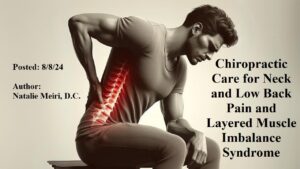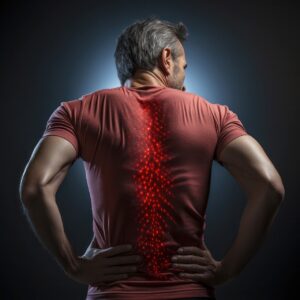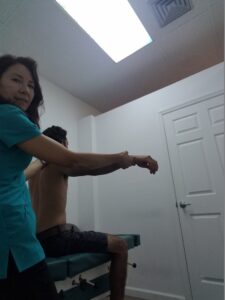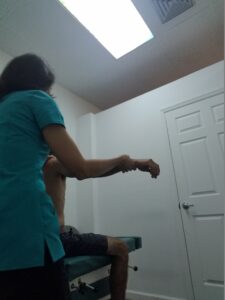
From Dr. Natalie Meiri’s Clinical Pearl Stories:
Chiropractic Care for Neck and Low Back Pain and Layered Muscle Imbalance Syndrome
This was a 58 year old patient who had neck and back pain. To be HIPAA compliant, I will call him Harry instead of his real name. Harry had treated with another chiropractor prior to seeing me. He had gone to acupuncture, an orthopedist and physical therapy for his chief complaints. However, Harry still had pain in his neck and lower back. Harry presented to my office after difficulty in activities of daily living due to his neck and back condition.
Harry worked as a truck driver for 20 years and attributed some of his neck and back problems to his daily work activity. However, he also liked various sports and stated, “did injure himself from time to time”. Harry also had been in multiple car accidents which he had residual pain from even after care.
HChiropractic Care for Neck and Low Back Pain and Layered Muscle Imbalance Syndrome-
Harry’s Examination and Imaging
Upon examination, there were positive tests for his neck and low back pain.
Harry had X-rays from his previous doctor. The findings in his x-rays were moderate to severe osteoarthritis (wear and tear arthritis) throughout his spine.
I would order a M.R.I. if he wasn’t improving in a month or 12 visits. Harry had osteoarthritis (as seen on his x-rays) and Layered muscle imbalance syndrome was detected during my exam:
Harry’s gluteus maximus was totally inactive/weak and extension (of thigh) was performed almost exclusively by his hamstrings and thoracolumbar (midback and low back) muscle segments. Moreover, he had dysfunction in his upper trapezius, levator scapulae, cervical (neck) flexors, (pectoral muscles, rhomboids, serratus muscles, and latissimus dorsi. Additionally, his illiopsoas and hip flexors were overactive and shortened.

Chiropractic Care for Neck and Low Back Pain and Layered Muscle Imbalance Syndrome-
What is Muscle Imbalance Syndrome?
Obviously, there are some differences in muscle strength which cause a normal imbalance. After all, not all muscles are equal. The smaller muscles tend to react rapidly and strongly to a stimulus and are called phasic. Similarly, the larger muscles hold our posture and are called tonic. And then certain movement patterns are notable. For example, internal (inward) rotation of the shoulder is stronger than external (outward) rotation of the shoulder. Additionally, the size and number of the muscles used for the particular movement matters. Alternatively, position also makes your balance of muscles stronger or weaker. However, there is another point of view clinically in regards to muscle imbalance; weakness and tightness. This type of muscle imbalance is dysfunctional and needs evaluation and treatment to correct.
Muscle imbalance Syndrome is when some of your muscles become shortened/tight and overactive or weak and inhibited. Inhibition means that the neural connection is absent, bypassed, incomplete, weak, or overridden. Moreover, this often happens to specific muscles. Typically, postural antigravity slow-twitch muscles tend to tighten and shorten. In contrast, the phasic fast twitch muscles usually weaken and elongate.
What is Upper Cross Syndrome?
Upper cross syndrome causes altered muscle activation and movement patterns of the head, neck, shoulders, and back muscles. The muscles involved can be shortened (tightened) and overactive or stretched, weakened and inactive. For example, muscles of the neck and posterior (back) upper back, such as the deep neck flexors, serratus anterior, rhomboids, middle trapezius, and lower trapezius, are weakened, stretched, and inactive. Additionally, the “tightness” of the suboccipitalis, levator scapulae, and Upper trapezius on the back side is crossed by the “tightness” of the pectoralis major and minor, SCM, and scalenes on the front side. The weakness of the deep neck flexors on the front side is crossed by the weakness of the serratus anterior, rhomboids, middle trapezius, and lower trapezius on the back side.
These muscle imbalances can cause bad posture, misalignments in the neck, mid back and upper extremities (limb) causing neck pain, chest pain, upper back pain, tingling in the upper arms and decreased range of motion in the same areas.
Postural changes due to upper cross syndrome include: Forward head posture, cervical hyperlordosis, thoracic hyperkyphosis, protracted and elevated shoulders (round shoulders), and scapular winging.
What is Lower Cross syndrome?
Lower cross syndrome is characterized by shortened hamstrings, overactive/tight hip flexors, iliopsoas and lumbar spinal erectors due to improper conditioning or from prolonged sitting. And the inactivity can result in weakness to the gluteal and abdominal muscles.
Furthermore, it may promote a pelvic tilt of the lumbar spine. And this will create dysfunction and back pain. The overactive/shortened muscles can include in the kinetic chain: gastrocnemius/ soleus (calf muscles), hip flexors, hamstrings, adductors, tensor fascia Lata (t.f.l.) and piriformis. The underactive/inhibited muscles could include the gluteus maximus, gluteus medius, quadratus plantae (foot muscle), peronei (shin muscle), and abdominal wall muscles.
For example, the gluteus medius becomes weak and quadratus lumborum takes over for gluteus medias to stabilize the body. When the quadratus lumborum becomes overactive, postural changes take place. Continuation of the incorrect movement causes microtrauma throughout the mid and low back spine and sacral areas. Eventually it could even effect the hip joints patella femoral (knee cap) joints and shin/ankle/ arches of the feet. Indeed it becomes a self perpetuating cycle of dysfunction and pain.



West Palm Beach Chiropractor: Causes of Muscle Imbalance Syndrome
While there are many reasons for muscle imbalance, the most common cause may be chronic overuse or traumatic injury. Without proper treatment, there is a muscle elasticity change. Of course, having a sedentary lifestyle without a variety of movements also causes imbalance. Your connective tissue will shorten over time if left in the same position for long. Indeed, forced movements, stress, and even fatigue can lead to muscle imbalance. Next, this can even effect your central nervous system. Your nervous system remembers these imbalances of abnormal movement patterns. Also, even though appearing often together, a muscle that is tight, shortened and overactive is not the same as muscle spasm. This Tightness is due to hypertrophy (overgrowth) of the connective tissue.
Ultimately, combinations of tight and weak muscles have abnormal movement patterns that changes the biomechanics of joints. And this can lead to degenerative (wear and tear) changes throughout the spine and extremities or/and fixated joints.
Chiropractic Care for Muscle Imbalance Syndrome at Meiri Chiropractic
Generally, practitioners test muscle strength to evaluate imbalance. With muscle imbalance syndrome, some Researchers introduced using movement patterns as part of the evaluation.
Firstly, when the patient first presents, it’s important to get them out of pain. So the total treatment of the chronicity should begin with restoring as much joint motion by chiropractic adjustments/manipulation as possible and substantially decreasing pain before balancing the muscular system.
Secondly, for treatment of the muscle imbalance, post-isometric relaxation and proprioceptive neuromuscular facilitation (PNF) techniques are utilized.
Thirdly, proprioceptive (sense that lets us perceive the location and movements of our body parts) training is incorporated. This is done with various balance activities (e.g. wobble boards, exercise balls, trampolines). Studies show these types of activities help the nervous system on a subconscious level regarding the new correct movement pattern. The result is improvement of gait, coordination, body posture, and stabilization.
Chiropractic Care for Neck and Low Back Pain and Layered Muscle Imbalance Syndrome-Harry’s Outcome
The outcome for Harry was excellent! He started feeling better immediately from the first few visits. His range of motion greatly improved and he was able to do the activities he wasn’t able to do prior to treatment. By the end of his corrective care, he was pain-free and functioning optimally. Harry returned for once a month supportive/maintenance care there after.
Chiropractic Care for Neck and Low Back Pain and Layered Muscle imbalance Syndrome
Do you know someone who is in need of chiropractic care for Layered Muscle imbalance Syndrome? Contact Dr. Natalie Meiri of Meiri Chiropractic today at 561-253-8984 to make an appointment or to learn more about Chiropractic Care for Neck and Low Back Pain and Layered Muscle imbalance Syndrome.